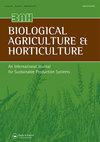覆盖作物种类及终止方式对有机玉米和大豆的影响
IF 1.6
4区 农林科学
Q3 AGRONOMY
引用次数: 14
摘要
摘要机械覆盖作物(CC)终止可以减少有机轮作中的耕作,但需要进行研究,为美国中西部上游的生产者制定建议。2008年至2009年和2009年至2010年,在美国东北部康科德附近进行了实地研究。本研究比较了免耕[滚筒/卷曲机(CRIMP)和广播丙烷火焰(flame)]和弹簧盘(disk)终止豆类、草和阔叶CC及其对后续玉米或大豆作物的影响。播种前,越冬CC种被终止;霜冻致死(frost)CC也在春季被圆盘化。杂草是通过在耕作系统(DISK和FROST)中种植来控制的;CC残留物作为表层覆盖物留在免耕系统(CRIMP和FLAME)中。终止方法/耕作制度对粮食产量和质量的影响比CC物种更大,耕作处理比CRIMP和FLAME表现更好,这可能是由于免耕处理中的早季杂草压力和低林分建立。在两次试验中,DISK系统的玉米产量平均为6.8 Mg ha−1,而FLAME和CRIMP的产量减少了57–78%。DISK的大豆产量分别为3.3和2.0 Mg ha−1;2009年,CRIMP和FLAME的产量减少了21-33%,2010年减少了56%。最适合免耕系统的CC是冬黑麦(优越的生物量)和毛豌豆(成功的机械终止)。执行FLAME和CRIMP。结果表明,应在综合杂草管理系统中采用免耕CC终止,以最大限度地减少杂草和CC再生造成的产量损失。本文章由计算机程序翻译,如有差异,请以英文原文为准。
Cover crop species and termination method effects on organic maize and soybean
Abstract Mechanical cover crop (CC) termination can reduce tillage in organic rotations, but research is needed to develop recommendations for producers in the upper Midwest, U.S.A. Field studies were conducted near Concord, NE, U.S.A., in 2008–2009 and 2009–2010. This study compared no-till [roller/crimper (CRIMP) and broadcast propane flame (FLAME)] and spring disk (DISK) termination of legume, grass, and broadleaf CCs and their effects on a subsequent maize or soybean crop. Before sowing the grain, overwintering CC species were terminated; frost-killed (FROST) CCs were also disked in the spring. Weeds were controlled via cultivation in the tilled systems (DISK and FROST); CC residue was left as a surface mulch in the no-till systems (CRIMP and FLAME). Termination method/tillage regime had greater influence than CC species on grain yield and quality, with tilled treatments performing better than CRIMP and FLAME, likely due to early season weed pressure and low stand establishment in the no-till treatments. Maize yield for the DISK system was on average 6.8 Mg ha−1 in both trials, while FLAME and CRIMP produced 57–78% less. Soybean yields for DISK were 3.3 and 2.0 Mg ha−1; CRIMP and FLAME produced 21–33% less in 2009 and 56% less in 2010. The CCs best suited to no-till systems were winter rye (superior biomass) and hairy vetch (successful mechanical termination). FLAME performed as well as CRIMP. The results suggested that no-till CC termination should be employed within a comprehensive weed management system to minimise yield losses due to weeds and CC regrowth.
求助全文
通过发布文献求助,成功后即可免费获取论文全文。
去求助
来源期刊
CiteScore
3.30
自引率
6.70%
发文量
18
审稿时长
>36 weeks
期刊介绍:
Biological Agriculture & Horticulture aims to act as the central focus for a wide range of studies into alternative systems of husbandry, and particularly the biological or organic approach to food production. The Journal publishes work of a sound scientific or economic nature related to any aspect of biological husbandry in agriculture, horticulture and forestry in both temperate and tropical conditions, including energy and water utilization, and environmental impact.

 求助内容:
求助内容: 应助结果提醒方式:
应助结果提醒方式:


